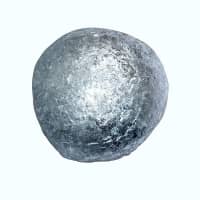Zinc plays an essential role in human health. The human body maintains a tight regulation of zinc homeostasis both systemically and intracellularly.[1]
The food plants that contain the most zinc are wheat (germ and bran) and various seeds, including sesame, poppy, alfalfa, celery, and mustard.
Zinc is also found in beans, nuts, almonds, whole grains, pumpkin seeds, sunflower seeds, and blackcurrant.
Certain foods such as pulses and cereals may interfere with zinc absorption due to their phytate content.
Composition
Zinc mineral supplements are ususally found in the following forms:
Zinc oxide
Zinc oxide is one of the most common supplements. However, it is nearly insoluble and poorly absorbed in the body.
Zinc carbonate
Zinc carbonate is another form nearly insoluble and poorly absorbed in the body
Zinc acetate
Zinc gluconate
Zinc sulfate
Healing Properties
Antioxidant
Zinc is an exogenous antioxidant (exogenous antioxidants are antioxidants we get from our diet by eating antioxidant-rich foods and by taking supplements).[2] [3]
Antiviral
Zinc can stimulate a variety of signaling events, including the antiviral response.[1:1]
- Free zinc may possess potent antiviral effects.[1:2]
- For example: creams, lozenges, and supplements with high free zinc content.
- Zinc-binding proteins such as the ‘metallothioneins’ may possess antiviral roles.[1:3]
- The production of metallothioneins (which are synthesised primarily in the liver and kidneys) is dependent on the availability of dietary minerals such as zinc, copper, and selenium, as well as the amino acids histidine and cysteine.
Skin Health
Zinc can positively influence the effects of oxidative stress on cultured human retinal pigment epithelial (RPE) cells.[2:1]
UV Protection
Zinc-treated fibroblasts were more resistant to UVR than cells grown in normal medium.[2:2]
Disease / Symptom Treatment
Viral Infections
Herpes
Topical zinc has also been shown to effectively treat, as well as prolong remission in genital herpes.
Adverse Affects
Synergistic Effects
Read, S. A., Obeid, S., Ahlenstiel, C., & Ahlenstiel, G. (2019). The Role of Zinc in Antiviral Immunity. Advances in Nutrition. doi:10.1093/advances/nmz013 ↩︎ ↩︎ ↩︎ ↩︎
Study Type: Preprint: Review Paper
Title: An extensive Review of Sunscreen and Suntan Preparations
Author(s): AK Mohiuddin
Institution(s): Department of Pharmacy, World University of Bangladesh; 151/8, Green Road, Dhanmondi, Dhaka –1205, Bangladesh
Publication: Preprint
Date: April 2019
Abstract: The sunscreen industry is achieving remarkable worldwide prominence by responding to the growing need for skin protection with fast-paced innovation. Increased consumer awareness of the harmful effects of sunlight has fueled the demand for improved photo protection. The need for broad-spectrum protection from both UVA and UVB rays has inspired scientists worldwide to research new cosmetic formulations and delivery systems. More effective sunscreen actives, emollients and novel cosmetic and functional ingredients have been regularly added to the formulator’s repertoire. Creativity in innovation has been hindered only by regulatory agencies and patent restrictions worldwide. Familiarity with the current restrictive regulations and patent law infringements has become integral to any research effort attempting to provide improved protection to individuals affected by the sun’s damaging effects. The increasing incidence of skin cancers and photo damaging effects caused by ultraviolet radiation has increased the use of sun screening agents, which have shown beneficial effects in reducing the symptoms and reoccurrence of these problems. Unlike the situation in Europe where sunscreen ingredients are considered under cosmetics guidelines, the FDA is required to define sunscreens as drugs since they are advertised to prevent sunburn and, more recently, the risk of skin cancer. In the USA, the FDA has been regulating this industry since August 25, 1978, with the publication of the Advance Notice of Proposed Rulemaking. Sunscreens are considered drugs and cosmetics and therefore must be governed by the FDA-OTC monograph. With the variety of sunscreen agents used in cosmetic and UV protection products, Australia, Canada, and the European Union (EU) have also developed regulatory protocols on safe sunscreen product use. Unlike the USA though, Australia has approved 34 active sunscreen ingredients and the EU has approved 28 of these ingredients. Current FDA regulations allow labeling of sunscreen products to a maximum of 30þ, despite the many products currently available with numbers as high as 100. From a cosmetic formulation point of view, increasing the SPF number in a product is governed by simple chemical principles.
Link: Source
Citations: ↩︎ ↩︎ ↩︎“Endogenous And Exogenous Antioxidants Benefits.” UKEssays.com, Source. ↩︎
